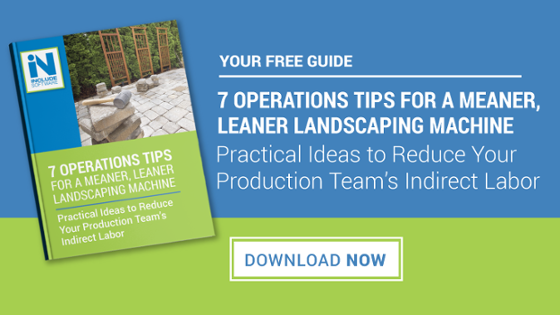 Do you feel as though your underperforming employees are dragging your landscape company down? If you do, you’re not alone. A survey performed by a leading staffing agency found that underperforming employees are a major concern in businesses across the country.
Do you feel as though your underperforming employees are dragging your landscape company down? If you do, you’re not alone. A survey performed by a leading staffing agency found that underperforming employees are a major concern in businesses across the country.
In the survey, respondents reported the managers at their companies spent an average of 17 percent of their time on underperforming employees. That’s nearly one day out of every week.
The problem is, managing underperforming employees is not only time consuming, it can also lead to a decline in morale among other employees. They may feel neglected or may even be influenced by the negative attitude of one or more of your underperformers.
Every landscape business owner expects the best from his or her employees and when it’s not happening, it can be frustrating for everyone. The best thing that you can do is take action and take it immediately. In the vast majority of cases, these types of problems are not going to correct themselves. You need to intervene and develop a measurable plan for improvement.
We’ll walk you through getting started.
Managing Underperforming Employees with One-on-One Meetings
Getting a handle on your underperforming employees requires face-to-face time. In other words, don’t try to have an important conversation about their performance over the phone—or even worse, via email. A one-on-one meeting is an excellent opportunity to address your concerns with your underperforming employees.
Hosting a one-on-one meeting gives you the chance to really assess what is going on with your employee. Your goal of the meeting should be getting to the heart of why their performance is declining.
Here are some questions that you might consider asking an underperforming employee.
How do you feel your performance has been lately?
This is an excellent place to start the conversation. Put the ball in your employee’s court and see how they feel about their performance. It’s possible they don’t realize they’re slipping. However, in most cases, employees realize when their performance is falling short. It can be helpful to hear in their words how they feel they’re doing.
Where are your struggling the most?
You might already know where you feel your employee is failing but perhaps they have different struggles in mind. Are there communication disconnects somewhere that you don’t know about? Do they feel as though they need more training in a certain area of the business? It’s important that you get to the root of where this employee is facing difficulties.
Do you feel supported in the work that you are doing?
Going off of the last question, you also want to make sure that your employees feel supported. Are you making sure that the tools they need are available for them?
For instance, a salesperson who is really struggling with estimating, might not have all the tools they need at their disposal. They might consistently be forgetting to add a certain line item to proposals. A tool such as landscape estimating software could help automate that process and support them in their work.
Or, an operations person might be slowing down the daily workload if he wasn’t properly trained on your company’s protocol. Perhaps he’s applying a certain “way of doing things” to the job that isn’t how he’s meant to do it for you—but nobody has ever told him otherwise.
What are you enjoying about the work?
It’s also important to find out whether this employee might lack motivation. Do they still like working for you and the company? Ask them to share what they enjoy about working for your company and you may start to unravel some important information about their level of motivation.
Are you feeling optimistic about the company’s future (and your role in the company’s future)?
Is this employee here for the long haul or are they looking for a way out? If you suspect your employee might feel as though their time at the company is coming to an end, and they’ve already got one foot out the door, then a one-on-one meeting could help you to potentially verify that suspicion.
If the employee does not continue to plan to work for you in the future, they may feel they have very little reason to be productive.
Preparing for a One-on-One with an Underperforming Employee
 Besides devising a list of questions that you plan to ask during the one-on-one meeting, you should also arm yourself with data regarding the employee’s performance. The performance data that you have about each employee should be the information upon which you’re basing your concerns.
Besides devising a list of questions that you plan to ask during the one-on-one meeting, you should also arm yourself with data regarding the employee’s performance. The performance data that you have about each employee should be the information upon which you’re basing your concerns.
In other words, your review of your employee’s performance should not be based on a “feeling” about how they’re doing. It should be based on hard data regarding their performance.
Data about attendance, for instance, would provide you with information on how often that person has been late for work or how often they’ve been a no-show. Tracking this data allows you to base your performance review on facts, not guesses. It can also open the door to a productive conversation with your employe.
Perhaps they don’t even realize just how often they’ve been late or why it’s such a problem. They may feel attacked by what they suspect are presumptions on your behalf. But if you’ve been tracking these numbers, the data will speak for itself.
Or maybe the problem isn’t that the employee is late but that they’re not productive when they’re in the field. With landscape business software, you’d be able to track job costing to calculate how truly efficient your people are being.
In addition, having a place to store all of this data and easily retrieve it in real time is key. With landscape business software you can not only track various pieces of data, but you can store and retrieve the information at any time.
You should even be keeping notes from your one-on-one meetings and plan to store that information so that you can truly track your employee’s progress.
What if the Problem is You?
It’s worth mentioning that sometimes the problem isn’t the employee. You must also take this opportunity to reflect inward. Are you falling short in some way? Are there areas where you can better support this employee in order to help them do their job better? Failing to ensure the employee has all the tools they need to succeed is one such example.
That’s why you should be sure to take the opportunity to self-reflect, as well. After all, if this is an employee that you want to keep, then your goal should be reaching a point where they have what they need to succeed—even if that means making some changes on your end.
Even if it’s not specifically about you, maybe it’s the way your company is structured. Perhaps the employee is falling short because you don’t have the best systems in place. You might need to make improvements to the company’s structure in order to better support your people.
What if it’s an External Factor?
It’s also important to mention that sometimes the problem has absolutely nothing to do with work. Be prepared to consider the fact that the underperformance could be due to external factors, such as something going on in the employee’s personal life.
This is even more possible if the decline in performance comes on suddenly. If that’s the case, it could be a temporary situation. This is one such circumstance where the problem could resolve itself. Everything from relationship trouble to a family member’s illness or even a new child can affect performance.
Oftentimes, if you’re already been performing regular one-on-one meetings, then you’ve probably opened the channel of communication and are well aware of these circumstances. But sometimes employees at your landscaping company are struggling outside of work and aren’t upfront about their circumstances.
Certain issues like financial struggles or even mental illness can feel “taboo” and lead to an employee struggling in silence. The National Institute for Mental Health estimates that depression accounts for almost $11 billion in lost productivity each year.
A one-on-one meeting that produces meaningful conversation should helpfully put you on a path toward understanding what is going on with your employee, even if it’s an external factor at play.
Focusing on the Goals of a One-on-One Meeting
 Ultimately, the goal of asking all of these questions and presenting performance data during a one-on-one meeting is to get to a place of understanding. You want to know what’s going on with your employee. That’s why asking questions will ease the conversation into a place where your employee feels comfortable opening up and expressing what’s at the root of their poor performance.
Ultimately, the goal of asking all of these questions and presenting performance data during a one-on-one meeting is to get to a place of understanding. You want to know what’s going on with your employee. That’s why asking questions will ease the conversation into a place where your employee feels comfortable opening up and expressing what’s at the root of their poor performance.
The last thing that you want is for the employee to instantly go on the defense or start slinging accusations. That’s not going to facilitate an open conversation. An accusatory question such as: “What do you think you are doing wrong?” is going to immediately set a negative tone to the meeting. But leading questions will guide the conversation in the direction you want to go without putting your employee on the defense.
Recognizing Positive Changes
There’s no doubt that managing underperforming employees can be a frustration. But by staying on top of what’s going on with your employees and taking action at the first sign of a problem, getting things back on track should be achievable.
Of course, be sure not to forget to praise your employee when you notice they’re making positive changes. Verbal recognition can go a long way in encouraging employees to stay on track.
And don’t give up on one-on-one meetings just because things are turning around. Keep that communication channel open and next time your employee may come to you as soon as they’re experiencing a concern that is slowing them down. By doing so, you just may be able to nip a problem in the bud before it becomes a major issue.
If you’re ready to see how landscape business software can help you better manage underperforming employees, or you have questions we can help with, then let’s explore and see what Asset can do for you.
Image sources: Level Green Landscaping, T. Lake Environmental Design



